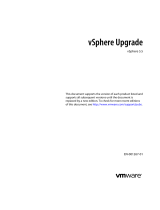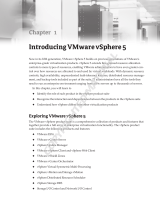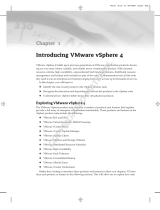Page is loading ...

Administrator Guide
VMware vCenter Server Heartbeat 6.3 Update 1
This document supports the version of each product listed and
supports all subsequent versions until the document is replaced
by a new edition. To check for more recent editions of this
document, see http://www.vmware.com/support/pubs.
EN-000562-01

VMware, Inc.
3401 Hillview Ave.
Palo Alto, CA 94304
www.vmware.com
2 VMware, Inc.
Administrator Guide
You can find the most up-to-date technical documentation on the VMware Web site at:
http://www.vmware.com/support/
The VMware Web site also provides the latest product updates.
If you have comments about this documentation, submit your feedback to:
docfeedback@vmware.com
Copyright © 2010 VMware, Inc. All rights reserved. This product is protected by U.S. and international copyright and
intellectual property laws. VMware products are covered by one or more patents listed at
http://www.vmware.com/go/patents.
VMware is a registered trademark or trademark of VMware, Inc. in the United States and/or other jurisdictions. All other marks
and names mentioned herein may be trademarks of their respective companies.

VMware, Inc. 3
Contents
AboutThisBook 7
GettingStarted
1 Introduction 11
Overview 11
vCenterServerHeartbeatConcepts 11
Architecture 11
ProtectionLevels 13
Communications 16
vCenterServerHeartbeatSwitchoverandFailoverProcesses 17
2 ConfiguringvCenterServerHeartbeat 21
ServerConfigurationWizard 22
ConfiguringtheMachineIdentity 22
ConfiguringtheServerRole 23
ConfiguringtheClientConnectionPort 23
ConfiguringChannelRouting 23
ConfiguringtheDefaultChannelPort 24
ConfiguringLowBandwidthModule 24
ConfiguringPublicIPAddressing 24
ConfiguringforIdenticalNodes 25
ConfiguringforNon‐IdenticalNodes 25
ManagingvCenterServerHeartbeatLicenseKeys 26
ConfiguringMessageQueueLogs 27
ConfiguringtheMaximumDiskUsage 27
SystemAdministrationandManagement
3 ServerProtection 31
ServerProtectionOverview 31
CheckingtheServerPairStatus 31
MonitoringtheStatusofServers 33
ConfiguringHeartbeatSettings 33
ConfigurePings 33
ConfigureFailover 33
ConfiguringResponseTimes 34
CommonAdministrativeTasksinvCenterServerHeartbeat 34
ForcingaSwitchover 34
RecoveringFromaFailover 35
ConfiguringSplit‐BrainAvoidance 36
4 NetworkProtection 39
CommunicationStatus 39
ReviewingtheVMwareChannelStatus 39

Reference Guide
4 VMware, Inc.
ConfiguringPublicNetworkConnectionChecks 39
SettingMaxServerTimeDifference 40
5 ApplicationProtection 41
ApplicationProtectionOverview 41
ApplicationsTab 41
ResettheApplicationHealthStatus 41
ViewApplicationStatus 42
EditingIndividualApplications 42
RemoveanApplication 42
ManuallyStartandStopApplications 42
ConfiguringApplications 42
ApplicationMaintenanceMode 42
ReviewingtheStateofanApplication 43
ReviewingtheApplicationsLog 43
FilteringApplicationLogEntries 43
ServicesTab 43
AddingaService 43
EditingaService 44
CheckingtheStatusofServices 44
UnprotectingUserDefined
ServicesandStoppingMonitoring 44
ChangetheOrderofServices 44
RemovingaService 44
Applications:Tasks 45
AddingaTask 45
EditingaTask 45
RemoveaTask 45
ChangetheOrderofTasks 46
StartingaTaskManually 46
View,Add,andRemoveUserAccounts 46
Applications:Plugins 46
InstallaPlug‐In 46
EditingaPlug‐in 46
UninstallingaPlug‐in 47
6 StatusandControl 49
vCenterServerHeartbeatConsole 49
AboutvCenterServerHeartbeatConsole 49
NavigatevCenterServerHeartbeatConsole 50
ChangetheFontforvCenterServerHeartbeatConsole 50
WorkwithGroupsandPairs 50
AddorRemoveavCenterServerGroup 50
RemoveavCenterServerHeartbeatGroup 51
Add,Edit,Move,andRemovePairsinVCenterServerHeartbeatGroups 51
AddaNewConnection 51
EditaConnection 51
MoveaConnection 52
RemoveaConnection 52
EditUsernameandPasswordSettings 52
ReviewtheStatusofvCenterServerHeartbeatGroupsandPairs 52
ExitvCenterServerHeartbeatConsole 53
ShutDownWindowsWithoutStoppingvCenterServerHeartbeat 53
7 PerformanceProtection 55
Applications:Rules 55

VMware, Inc. 5
Contents
Rules 55
CheckingaRuleCondition 55
EditaRule 55
RulesInstalledbyvCenterServerHeartbeatPlug‐Ins 55
8 DataProtection 57
DataProtectionOverview 58
Replication 58
RegistryandFileSynchronizationStatus 58
InitiateaFullRegistryCheck 58
InitiateaFullSystemCheck 58
InitiateFileSynchronizationManually 59
InitiateVerifyandSynchronizeManually 59
FileFilters 59
DetermineEffectiveFilters 59
AddaUser‐DefinedInclusionFilter 60
AddaUser‐DefinedExclusionFilter 60
EditUserDefinedInclusion/ExclusionFilters 60
RemoveUser‐DefinedFilters 60
AutomaticFilterDiscovery 60
9 OtherAdministrativeTasks 61
ConfigureAlerts 61
ConfigureAlertReporting 61
TestAlertReporting 62
ConfigureEventLogFiles 62
ConfigureLogFileEmailRecipients 62
ReviewEventLogs 63
EventLogFilters 63
10 Troubleshooting 65
TroubleshootingUnexpectedBehaviors 65
TwoActiveServers 65
Symptoms 65
Causes 66
Resolution 66
TwoPassiveServers 67
Symptom 67
Causes 67
Resolution 67
SynchronizationFailures 68
ServicesRunningonthePassiveServer 68
VMwareChannelIncorrectlyConfigured 68
IncorrectorMismatchedDiskConfiguration 69
PassiveServerHasLessAvailableSpacethanActiveServer 69
RegistryStatusisOutofSync 70
ResourceIssues 70
RegistrySecurityIssues 70
ChannelDrops 70
PerformanceIssues 70
PassiveServerDoesNotMeet
MinimumHardwareRequirements 71
HardwareorDriverIssuesonVMwareChannelNICs 71
FirewallConnection 72
IncorrectVMwareChannelConfiguration 72
VMwarevCenterServerHeartbeatPacketFilterIsEnabledontheChannelNIC(s) 73

Reference Guide
6 VMware, Inc.
SubnetorRoutingIssues 74
LANDeployment 74
WANDeployment 74
MaxDiskUsageErrors 74
SendQueue 75
ReceiveQueue 75
MaxDiskUsageErrorMessages 75
[L9]ExceededtheMaximumDiskUsage(VCChannelExceededMaxDiskUsageException) 75
[L9]ExceededtheMaximumDiskUsageontheACTIVEServer 76
[L9]ExceededtheMaximumDiskUsageonthePASSIVEServer 76
[L20]OutofDiskSpace(VCChannelOutOfDiskSpaceException) 77
ApplicationSlowdown 78
PoorApplicationPerformance 78
Both
ServersCanAccommodatetheInitialLoadbuttheLoadHasIncreased 78
OneServerCanProvideAdequateResourceSupport,buttheOtherCannot 78
ScheduledResourceIntensiveTasks 79
Glossary 81

VMware, Inc. 7
TheAdministratorGuideprovidesinformationconfiguringVMwarevCenterServerHeartbeatnetwork
protection,applicationprotection,dataprotection,Split‐brainAvoidance,andmore.Tohelpyouprotectyour
VMwarevCenterServer,thebookprovidesanoverviewofprotectionofferedbyvCenterServerHeartbeat
andtheactionsthatvCenterServerHeartbeatcantakein
theeventofanetwork,hardware,orapplication
failure.
Intended Audience
ThisguideassumesthereaderhasworkingknowledgeofnetworksincludingtheconfigurationofTCP/IP
protocolsanddomainadministrationontheWindows™2003and2008platforms,notablyinActiveDirectory
andDNS.
VMware Technical Publications Glossary
VMwareTechnicalPublicationsprovidesaglossaryoftermsthatmightbeunfamiliartoyou.Fordefinitions
oftermsastheyareusedinVMwaretechnicaldocumentationgotohttp://www.vmware.com/support/pubs.
Overview of Content
ThisguideisdesignedtogiveguidanceontheconfigurationandadministrationofvCenterServerHeartbeat,
andisorganizedintothefollowingsections:
Preface—AboutThisBook(thischapter)providesanoverviewofthisguideandtheconventionsused
throughout.
Chapter1—IntroductionpresentsanoverviewofvCenterServerHeartbeatconceptsincludingthe
SwitchoverandFailoverprocesses.
Chapter2—ConfiguringvCenterServerHeartbeatshowsyouhowtousetheServerConfigurationWizard
toconfigureyournewinstallationofvCenterServerHeartbeat.
Chapter3—ServerProtectiongivesanoverviewofhowvCenterServerHeartbeatprovidesprotection
againstserversystemcrashorserverhardwarefailure,showsyouhowtochecktheserverpairstatus,and
explainshowtoconfiguresettings,shutdownoptions,andSplit‐BrainAvoidance.
Chapter4—NetworkProtectiondescribeshowvCenterServerHeartbeatprotectsagainstnetworkfailure
andprovidesawaytomonitorcommunicationstatus.Italsoexplainshowtoconfigurepublicnetwork
connectionchecksandmaximumservertimedifference.
Chapter5—ApplicationProtectiondiscusseshowvCenterServerHeartbeatmaintainstheprotected
applicationenvironmentensuringthatapplicationsandservicesstayaliveonthenetwork.
Chapter6—StatusandControlintroducesyoutothevCenterServerHeartbeatConsoleandshowsyou
howtoconfigureitslookandfeel.
About This Book

Administrator Guide
8 VMware, Inc.
Chapter7—PerformanceProtectiondescribeshowvCenterServerHeartbeatmonitorssystemand
applicationattributestopreventanunexpectedsystemorapplicationfailure.
Chapter8—DataProtectiondiscusseshowvCenterServerHeartbeatinterceptsalldatawrittenbyusers
andprotectedapplicationsandmaintainsacopyofthisdataforuseincaseoffailure.
Chapter9—OtherAdministrativeTasksdiscussesadditionaltasksfortheadministratortoconfigure
systemloggingandalertingfunctions.
Chapter10—Troubleshootingprovidestechniquestotroubleshootcommonissuesandunexpected
behaviors.
Document Feedback
VMwarewelcomesyoursuggestionsforimprovingourdocumentationandinvitesyoutosendyourfeedback
Abbreviations Used in Figures
ThefiguresinthisbookusetheabbreviationslistedinTable 1.
Technical Support and Education Resources
Thefollowingsectionsdescribethetechnicalsupportresourcesavailabletoyou.Toaccessthecurrentversion
ofthisbookandotherbooks,gotowww.vmware.com/support/pubs.
Online and Telephone Support
Gotowww.vmware.com/supporttouseonlinesupporttosubmittechnicalsupportrequests,viewyour
productandcontractinformation,andregisteryourproducts.
Gotowww.vmware.com/support/phone_support.htmltofindouthowtousetelephonesupportforthe
fastestresponseonpriority1issues(appliestocustomerswithappropriatesupportcontracts).
Support Offerings
Gotowww.vmware.com/support/servicestofindouthowVMwaresupportofferingscanhelpmeetyour
businessneeds.
VMware Professional Services
Gotowww.vmware.com/servicestoaccessinformationabouteducationclasses,certificationprograms,and
consultingservices.VMwareEducationServicescoursesofferextensivehands‐onlabs,casestudyexamples,
andcoursematerialsdesignedforuseason‐the‐jobreferencetools.Coursesareavailableonsite,inthe
classroom,andliveonline.Foronsitepilot
programsandimplementationbestpractices,VMwareConsulting
Servicesprovidesofferingstohelpyouassess,plan,build,andmanageyourvirtualenvironment.
Table 1. Abbreviations
Abbreviation Description
Channel VMwareChannel
NIC NetworkInterfaceCard
P2P PhysicaltoPhysical
P2V PhysicaltoVirtual
V2V VirtualtoVirtual

VMware, Inc. 9
Getting Started

Reference Guide
10 VMware, Inc.

VMware, Inc. 11
1
Thischapterincludesthefollowingtopics:
“vCenterServerHeartbeatConcepts”onpage 11
“vCenterServerHeartbeatSwitchoverandFailoverProcesses”onpage 17
Overview
vCenterServerHeartbeatisaWindowsbasedservicespecificallydesignedtoprovidehighavailability
protectionforvCenterServerconfigurationswithoutrequiringanyspecializedhardware.
vCenter Server Heartbeat Concepts
Architecture
vCenterServerHeartbeatsoftwareisinstalledonaPrimary(production)serverandaSecondary
(ready‐standby)server.Thesenamesrefertothephysicalhardware(identity)oftheservers.
Dependingonthenetworkenvironment,vCenterServerHeartbeatcanbedeployedinaLocalAreaNetwork
(LAN)orWideAreaNetwork(WAN).Additionally,
vCenterServerHeartbeatallowsforinstallationusing
identicalnodes(LANandWAN )ornon‐identicalnodes(LANonly).Thesefeaturesprovideflexibility
necessarytoaddressmostnetworkenvironments.
Dependingonthenetworkenvironmentandarchitectureselected,vCenterServerHeartbeatcanbe
configuredwherethePrimaryandSecondaryserverhavethesame
domainnameandPrincipal(Public)IP
address(identicalnodes)orwherethePrimaryandSecondaryservershavedifferentdomainnamesbutshare
thePrincipal(Public)IPaddress(non‐identicalnodes).Ineitherarchitecture,theSecondaryserverinthewill
havethesamefileanddatastructureandcanrunallof
thesameapplicationsandservicesasthePrimary
server.ThevCenterServerHeartbeatsoftwareissymmetricalinalmostallrespects,andeitherthePrimary
serverortheSecondaryservercantaketheactiveroleandprovideprotectedapplicationstotheuser.
Whendeployed,vCenterServerHeartbeatusestwoserv erswith
eitheridenticalPrincipal(Public)IP
addressesforidenticalnodesorasharedPrincipal(Public)IPaddressfornon‐identicalnodes.Oneofthe
serversperformstheroleoftheactiveserverthatisvisibleonthePublicnetworkwhiletheotheristhepassive
serverthatishiddenfromthePublic
networkbutremainsasaready‐standbyserver.Onlyoneservercan
displaythePrincipal(Public)IPaddressandbevisibleonthePublicnetworkatanygiventime.
Identical Nodes Configuration
Whenconfiguredforidenticalnodes,vCenterServerHeartbeatusestwoserverswiththesamedomainname,
Principal(Public)networkIPaddress,
fileanddatastructure,applications,andservicestoensurethatvCenter
Serverisrunning andavailable.WithapacketfilterinstalledonbothserversPrincipal(Public)NICs,vCenter
ServerHeartbeatappliesthepacketfiltertothePrincipal(Public)NIConthepassiveservertherebyblocking
communicationsandhidingthepassiveserver
fromthePublicnetwork.Whenaswitchoveroccurs,thepacket
Introduction
1

Installation Guide
12 VMware, Inc.
filteronthecurrentlyactiveserverisenabledpreventingcommunicationsonthePublicnetworkwhilethe
packetfilteronthecurrentlypassiveserverisdisabledtherebyallowingthetwoserverstoswitchroles.From
thispointon,thepreviouslypassiveserverisnowactiveandservicingtheclients.Thepreviouslyactive
server
isnowpassiveandhiddenfromthePublicnetwork.
Intheeventofafailover,thepreviouslyactiveserverisdeemedtohavefailedandnofurtheractionsare
necessary.Thepacketfilteronthepreviouslypassiveserverisdisabledallowingtheservertobecomevisible
onthePublic
networkandserviceclientsasthenewactiveserver.
Advantages of Identical Nodes Configuration
IdenticalnodeconfigurationprovidesforasimplifiedinstallationandsupportsVirtualtoVirtual,Virtualto
Physical,andPhysicaltoPhysicalarchitectures.Additionally,identicalnodeconfigurationsupportsuseof
boththePre‐cloneandInstallclone,installationtechniques.Whenconfiguredwithidenticalnodes,
vCenter
ServerHeartbeatprovidestwoidenticalserversthatcanfunctionastheactiveserverservicingclients.
Additionally,withidenticalnodes,organizationscandeployvCenterServerHeartbeatinWANenvironments
therebyextendingprotectionoverwidegeographicdistances.
Non-Identical Nodes Configuration
Non‐identicalnodeconfigurationprovidesenhancedmanagementcapabilitiestothevCenterHeartbeat
Serverclusterbyprovidingcontinuousaccesstothepassiveserversimultaneouslywhiletheactiveserver
continuestoserviceclients.Whenconfiguredwithnon‐identicalnodes,vCenterServerHeartbeatusesunique
servernamesforeachserverandenhancedIPaddress
managementcapabilitiestoaccommodateMicrosoft
(updatable)DNSserversandLockedDownmodeornon‐MicrosoftDNSserverswhileprovidingthesame
levelsofprotectionaswhenconfiguredwithidenticalnodes.
TheSecondaryserverhasadifferentFullyQualifiedDomainName(FQDN)thanthePrimaryserverbutuses
thesamefile
anddatastructure,samePrincipal(Public)networkaddress,andcanrunallthesame
applicationsandservicesasthePrimaryserver.WithvCenterServerHeartbeatsoftwaresymmetricalin
almostallrespects,eitherthePrimaryserverortheSecondaryservercanassumetheactiveroleandprovide
protectedapplicationstotheuser.
Additionally,thisconfigurationallowsthepassiveservertobeeasilyaccessedformaintenancepurposes,
updatinganti‐virusdefinitionfiles,receivingoperatingsystemhot‐fixes,updatesandpatchesfrom
third‐partymanagementsoftware,andallowsuseofthird‐partymonitoringtools.
Switchover/Failover Without Updating DNS Servers
SelecttheNon‐IdenticaloptionwhenyouwanttodeployvCenter
ServerHeartbeatwithnon‐identicalnodes
inanenvironmentthatdoesnotpermitupdatingDNS(anon‐updatableMicrosoftDNSserver(orLocked
DownMode)oranon‐MicrosoftDNSserver).ThisconfigurationrequiresvCenterServervCenterServer4.0
Update1orlater,ifSQLServerisdeployed,itmust
beremote,andsinceDNSwillnotbeupdated
automatically,youmustprepopulatetheDNSserverwithentriesforthenewmanagementnamesandIP
addressesofthePrimaryandSecondaryservers.vCenterServerHeartbeatusespermanentlyassignedunique
ManagementIPaddressesonboththePrimaryandSecondaryservers.AdjacentIP
addressesshouldbe
reservedandusedforthePrincipal(Public)IPaddressandtheManagementIPaddressesforthePrimaryand
SecondaryServerswheninstallingvCenterServerHeartbeatonnon‐identicalnodesonserversrunning
Windows2008.WhenvCenterServerHeartbeatisstarted,thesharedPrincipal(Public)IPaddressis
provided
totheactiveserver.Whenaswitchoveroccurs,thesharedPrincipal(Public)IPaddressisremovedfromthe
previouslyactiveserver(makingitpassive)andprovidedtothepreviouslypassiveserver(makingitactive)
allowingtheserverstoswitchrolesandthenewactiveservertobeginservicingclients.
Microsoft DNS Server Updated During Switchover/Failover
Select
theNon‐identical(UpdatesMSDNS)optionwhenyouwanttodeployvCenterServerHeartbeatwith
non‐identicalnodesinanenvironmentwherevCenterServer4.0Update1orlaterisinstalled,ifSQLServer
isdeployeditmustberemote,aMicrosoftDNSserverthatpermitsupdatesisused,
andyouwanttotake
advantageoftheenhancedpassiveservermanagementcapabilities.vCenterServerHeartbeatinteractswith
theDNSserverandfollowingaswitchover,willensurethatserversarecorrectlyidentifiedonthenetworkby
updatingDNSinformation.vCenterServerHeartbeatusesuniqueservernamesandManagementIP

VMware, Inc. 13
Chapter 1 Introduction
addressesforthePrimaryandSecondaryserversseparatefromthesharedPublic(Principal)IPaddress.
ClientsconnecttovCenterServerusingauniquevirtualservicenameconfiguredinvCenterServerHeartbeat
thatresolvestothePublic(Principal)IPaddress.Whenstarted,vCenterServerHeartbeatprovidesthepassive
serveritsuniqueManagement
IPaddressandprovidestheactiveserverwiththesharedPrincipal(Public)IP
address.
Whenaswitchoveroccurs,vCenterServerHeartbeatremovesthesharedPrincipal(Public)IPaddressfrom
thecurrentlyactiveserverandreplacesitwithitsuniqueManagementIPaddress.Onthecurrentlypassive
server,vCenterServerHeartbeatremoves
theManagementIPaddressandreplacesitwiththeshared
Principal(Public)IPaddresstherebyallowingtheserverstoswitchroles.
Advantages of Non-Identical Nodes Configuration
Deploymentofnon‐identicalnodesallowsforeasyaccesstothepassive(hidden/readystandby)serveratany
timeregardlessofwhichserverisactiveandservicingclients.Additionally,this
configurationallowsthe
passiveservertobeeasilyaccessedformaintenancepurposes,updatinganti‐virusdefinitionfiles,receiving
operatingsystemhot‐fixes,updatesandpatchesfromthird‐partymanagementsoftware,andallowsuseof
third‐partymonitoringtools.
Protection Levels
vCenterServerHeartbeatprovidesthefollowingprotectionlevels:
ServerProtection–vCenterServerHeartbeatprovidescontinuousavailabilitytoendusersthrougha
hardwarefailurescenariooroperatingsystemcrash.Additionally,vCenterServerHeartbeatprotectsthe
networkidentityoftheproductionserver,ensuringusersareprovidedwithareplicaserveronthefailure
oftheproductionserver.
NetworkProtection–vCenterServerHeartbeatproactivelymonitorsthenetworkbypollinguptothree
nodestoensurethattheactiveserverisvisibleonthenetwork.
ApplicationProtection–vCenterServerHeartbeatmaintainstheapplicationenvironmentensuringthat
applicationsandservicesstayaliveonthenetwork.
PerformanceProtection–vCenterServerHeartbeatproactivelymonitorssystemperformanceattributes
toensurethatthesystemadministratorisnotifiedofproblemsandcantakepre‐emptiveactiontoprevent
anoutage.
DataProtection–vCenterServerHeartbeatinterceptsalldatawrittenbyusersandapplications,and
maintainsacopyofthisdataonthepassiveserverthatcanbeusedintheeventofafailure.
vCenterServerHeartbeatprovidesallfiveprotectionlev elscontinuously,ensuringallfacetsoftheuser
environment
aremaintainedatalltimes,andthatthenetwork(Principal(Public)network)continuesto
operatethroughasmanyfailurescenariosaspossible.
Server Protection
vCenterServerHeartbeatprovidescontinuousavailabilitytoendusersthroughahardwarefailurescenario
oroperatingsystemcrash.Additionally,vCenterServerHeartbeatprotectsthenetworkidentityofthe
productionserver,ensuringusersareprovidedwithareplicaserverincludingservername(singleidentity
only),IPaddressonthefailureofthe
productionserver.
TwoinstancesofvCenterServerHeartbeatregularlysend“I’malive”messagesandmessage
acknowledgmentstooneanotheroveranetworkconnectionreferredtoastheVMwareChanneltodetect
interruptionsinresponsiveness.Ifthepassiveserverdetectsthatthismonitoringprocess(referredtoasthe
heartbeat)hasfailed,it
initiatesafailoverasillustratedinFigure 1‐1.

Installation Guide
14 VMware, Inc.
Figure 1-1. Failover
Afailoverissimilartoaswitchoverbutisusedinmoreurgentsituations,suchaswhenthepassiveserver
detectsthattheactiveserverisnolongerresponding.Thiscanoccurwhentheactiveserverhardwarefails,
losesitsnetworkconnections,orotherwisebecomesunavailable.Ratherthantheactive
servergracefully
closing,thepassiveserverdeterminesthattheactiveserverhasfailedandrequiresnofurtheroperations.Ina
failover,thepassiveserverimmediatelyassumestheactiveserverrole.Thefailoverprocessisdiscussedlater
inthisguide.
Network Protection
vCenterServerHeartbeatproactivelymonitorsthenetworkbypollinguptothreenodestoensurethatthe
activeserverisvisibleonthenetwork.vCenterServerHeartbeatpollsdefinednodesaroundthenetwork,
includingthedefaultgateway,theprimaryDNSserver,andtheglobalcatalogserveratregularintervals.If
all
threenodesfailtorespond,forexample,inthecaseofanetworkcardfailureoralocalswitchfailure,
vCenterServerHeartbeatcaninitiateaswitchover,allowingtheSecondaryservertoassumeanidentical
networkidentityasthePrimaryserver.
Application Protection
vCenterServerHeartbeatrunningontheactiveserverlocallymonitorstheapplicationsandservicesithas
beenconfiguredtoprotect(throughtheuseofplug‐ins)toverifythatprotectedapplicationsareoperational
andnotinanunresponsiveorstoppedstate.Thislevelofmonitoringisfundamentalinensuringthat
applications
remainavailabletousers.
Ifaprotectedapplicationfails,vCenterServerHeartbeatfirsttriestorestarttheapplicationontheactiveserver
(1)inFigure 1‐2.
Iftheapplicationdoesnotsuccessfullyrestart,vCenterServerHeartbeatinitiatesaswitchover(2)in
Figure 1‐2.Referto“vCenterServerHeartbeatSwitchoverand
FailoverProcesses”onpage 17forfurther
informationabouttheswitchoverprocess.

VMware, Inc. 15
Chapter 1 Introduction
Figure 1-2. Switchover
Aswitchovergracefullyclosesanyprotectedapplicationsthatarerunningontheactiveserverandrestarts
themonthepassiveserver,includingtheapplicationorservicethatcausedthefailure.Intheexamplewhere
thePrimaryserverisactiveandtheSecondaryserverispassive,thePrimaryserverisdemoted
toapassive
roleandishiddenfromthenetworkwhentheSecondaryserverispromotedtoanactiveroleandismade
visibletothenetwork.Themechanicsofswitchoversarediscussedinmoredetaillaterinthisguide.
Performance Protection
Ensuringthatyourprotectedapplicationsareoperationalandprovidingserviceatalevelofperformance
adequateforuserstoremainproductiveisimportant.ThevCenterServerHeartbeatplug‐inprovidesthese
monitoringandpre‐emptiverepaircapabilities.
vCenterServerHeartbeatproactivelymonitorssystemperformanceattributestoensurethatthesystem
administrator
isnotifiedofproblemsandcantakepre‐emptiveactiontopreventanoutage.
Inadditiontomonitoringapplicationservices,vCenterServerHeartbeatcanmonitorspecificapplication
attributestoensurethattheyremainwithinnormaloperatingranges.Similartoapplicationmonitoring,
variousrulescanbeconfiguredtotriggerspecificcorrectiveactions
whenevertheseattributesfalloutsideof
theirrespectiveranges.
vCenterServerHeartbeatprovidesthesamelevelofflexibilitytodefineandperformmultiplecorrective
actionsintheeventofproblemsonaservicebyserviceorevenattributebyattributebasis.
Data Protection
YoucanconfigurevCenterServerHeartbeattoprotecttheapplicationenvironment.Alldatafilesthatusersor
theapplicationsrequireintheapplicationenvironmentaremadeavailableshouldafailureoccur.After
installation,vCenterServerHeartbeatconfiguresitselftoprotectfiles,folders,andregistrysettingsfor
vCenterServerontheactive
serverbymirroringtheminrealtimetothepassiveserver.Ifafailoveroccurs,all
filesprotectedonthefailedserverareavailabletousersafterthefailover,hostedontheSecondaryserver.
vCenterServerHeartbeatinterceptsallfilesystemI/Ooperationsontheactiveserver.Iftheinterceptedwrite
andupdateoperationsarewithintheprotectedset,theseareplacedinaqueueontheactiveserverreferredto
astheactiveserver’ssendqueue,pendingtransmissiontothepassiveserver.Eachrequestisnumberedto
maintainitsorderinthequeue.
Withtherequestintheactiveserver’ssend
queue,vCenterServerHeartbeatallowsthediskI/Otocontinue
withtherequesteddiskoperation.
Ifthechannelisconnected,theactiveserver’ssendqueueistransferredtothepassiveserver,whichplacesall
therequestsinthepassiveserver’sreceivequeue.Thepassiveserverconfirmsthechangeswereloggedby
sendingtheactiveserveranacknowledgement.Theactiveserverclearsthedatafromitsqueue.

Installation Guide
16 VMware, Inc.
Figure 1-3. Apply Process
Theapplyprocessrunningonthepassiveserver’sreceivequeueappliesallupdatesinstrictsequence,
duplicatinganidenticalsetoffileoperationsonthepassiveserverasillustratedinFigure 1‐3.
Communications
TheVMwareChannelisacrucialcomponentofthesetupandcanbeconfiguredinanumberofways.
BoththePrimaryandSecondaryserversmusthavetwoormorenetworkinterfaceconnections(NICs).
ThePrincipal(Public)networkrequiresoneNIC.TheVMwareChannelusesaseparateNICfortheprivate
connection
betweentheserversusedforcontrolanddatatransferbetweenthepairofservers.
AsecondpairofNICscanbeusedtoprovideadegreeofredundancyfortheVMwareChannel.Inthis
configuration,theVMwareChannelhasadualchannelifmorethanonededicatedNICisprovidedfor
the
VMwareChanneloneachserver.Toprovideaddedresilience,thecommunicationsforthesecondchannel
mustbecompletelyindependentfromthefirstchannel.Theymustnotshareanyswitches,virtualswitches,
routersorthesameWANconnection.
Figure 1-4. Communication Between Primary and Secondary Servers
TheIPaddressaclientusestoconnecttotheactiveserver
(thePrincipal(Public)IPaddress)mustbe
configuredasastaticIPaddress,thatis,notDHCP(DynamicHostConfigurationProtocol)enabled.Inthe
figureabove,theIPaddressisconfiguredas192.168.1.127.
NOTEObtaintheIPaddress:typeipconfigatthepromptinaDOSshell.Foradditionalinformationabout
theIPconfiguration,addtheswitch/All totheipconfigcommand.

VMware, Inc. 17
Chapter 1 Introduction
Whendeployedwithidenticalnodes,thePrincipal(Public)NICsonthepassiveserverareconfiguredtouse
thesameIPaddressasthatoftheactiveserverbutarepreventedfromcommunicatingwiththelivenetwork
throughanIPpacketfilteringsysteminstalledwithvCenterServerHeartbeat.Thispacketfilterprevents
trafficusingthePrincipal(Public)addressfrombeingcommittedtothewire.ItalsopreventsNetBIOStraffic
utilizingotherIPaddressesontheNICfrombeingsenttopreventNetBIOSnameresolutionconflicts.
TheNICsontheactiveandpassiveserversusedfortheVMwareChannelareconfiguredsothattheir
IP
addressesareoutsideofthesubnetrangeofthePrincipal(Public)network.Theseaddressesare referredtoas
VMwareChanneladdresses.
Duringinstallation,setupwillswitchoffNetBIOSfortheVMwareChannel(s)ontheactiveandpassive
serversasthisconnectionremainsliveandboththepassiveandactivemachines
havethesameNetBIOS
name.FollowingrestoreandafterthevCenterServerHeartbeatinstallationcompletes(runtime),NetBIOSis
disabledacrossthechannel(s).Thisoccursduringinstallationtopreventanameconflict,whichoccurswhen
bothservershavethesamename.
TheNICsthatsupportconnectivityacrosstheVMwareChannelcanbe
standard100BaseTEthernetcards
providingathroughputof100MbitspersecondacrossstandardCat‐5cabling.Initsmostbasicform,a
dedicatedchannelrequiresnohubsorrouters,butthedirectconnectionrequirescrossovercabling.
WhenconfiguredforaWANdeployment,configuretheVMwareChanneltousestaticroutes
overswitches
androuterstomaintaincontinuouscommunicationsindependentfromcorporateorpublictraffic.
vCenter Server Heartbeat Switchover and Failover Processes
vCenterServerHeartbeatusesfourdifferentprocedures—managedswitchover,automaticswitchover,
automaticfailover,andmanagedfailover—tochangetheroleoftheactiveandpassiveserversdependingon
thestatusoftheactiveserver.
Managed Switchover
YoucanclickMakeActiveonthevCenterServerHeartbeatConsoleServer:Summarypagetomanually
initiateamanagedswitchover.Whenamanagedswitchoveristriggered,therunningofprotected
applicationsistransferredfromtheactivemachinetothepassivemachineintheserverpair.Theserverroles
arereversed.
Figure 1-5.
Switchover
Amanagedswitchoverperformsthefollowingsteps:
1Stoptheprotectedapplicationsontheactiveserver.Aftertheprotectedapplicationsstop,nomoredisk
updatesaregenerated.
2Sendallupdatesthatarestillqueuedontheactiveservertothepassiveserver.Afterthisstep,allupdates
areavailableonthepassive
server.

Installation Guide
18 VMware, Inc.
3Re‐designatetheSecondaryserverasthenewactiveserver.Afterthisstep,vCenterServerHeartbeat:
Hidesthepreviouslyactiveserverfromthenetwork.
Makesthenewlyactiveservervisibleonthenetwork.Thenewlyactiveserverhasthesameidentity
asthepreviouslyactiveserver,andbeginstointerceptandqueuediskI/Ooperationsforthenewly
passiveserver.
4vCenterServerHeartbeatcausesthenewlypassiveservertobeginacceptingupdatesfromtheactive
server.
5vCenterServerHeartbeatstartsthesameprotectedapplicationsonthenewactiveserver.Theprotected
applicationsbecomeaccessibletousers.Themanagedswitchoveriscomplete
Automatic Switchover
Automaticswitchover(auto‐switchover)issimilartofailover(discussedinthenextsection)butistriggered
automaticallywhensystemmonitoringdetectsfailureofaprotectedapplication.
Likemanagedswitchover,auto‐switchoverchangestheserverrolesbutthenstopsvCenterServerHeartbeat
onthepreviouslyactiveservertoallowtheadministratorto
investigatethecauseoftheauto‐switchoverand
verifytheintegrityofthedata.
Afterthecausefortheauto‐switchoverisdeterminedandcorrected,theadministratorcanusevCenterServer
HeartbeatConsoletoreturntheserverrolestotheiroriginalstate.
Automatic Failover
Automaticfailoverissimilartoautomaticswitchover(discussedabove)butistriggeredwhenthepassive
serverdetectsthattheactiveserverisnolongerrunningproperlyandassumestheroleoftheactiveserver.
Figure 1-6. Failover
Duringtheautomaticfailover,thepassiveserverperformsthefollowingsteps:
1 Applyanyinterceptedupdatescurrentlyin
thepassiveserver’sreceivequeueasidentifiedbythelogof
updaterecordsthataresavedonthepassiveserverbutnotyetappliedtothereplicatedfiles.
Theamountofdatainthepassiveserver’sreceivequeueaffectsthetimerequiredtocompletethefailover
process.Ifthepassiveserver’s
receivequeueislong,thesystemmustwaitforallupdatestothepassive
servertocompletebeforetherestoftheprocesscantakeplace.Anupdaterecordcanbeappliedonlyif
allearlierupdaterecordsareapplied,andthecompletionstatusfortheupdateisinthe
passiveserver’s
receivequeue.Whennomoreupdaterecordscanbeapplied,anyupdaterecordsthatcannotbeapplied
arediscarded.
2Switchmodeofoperationfrompassivetoactive.

VMware, Inc. 19
Chapter 1 Introduction
Thisenablesthepublicidentityoftheserver.Theactiveandpassiveserversbothusethesamesystem
nameandsamePrincipal(Public)IPaddress.ThisPrincipal(Public)IPaddresscanbeenabledonlyon
onesystematanytime.Whenthepublicidentityisenabled,anyclientspreviouslyconnectedtothe
server
beforetheautomaticfailoverareabletoreconnect.
3Startinterceptingupdatestoprotecteddata.Anyupdatestotheprotecteddataaresavedinthesend
queueonthelocalserver.
4Startallprotectedapplications.Theapplicationsusethereplicatedapplicationdatatorecover,andthen
acceptre‐connectionsfromany
clients.Anyupdatesthattheapplicationsmaketotheprotecteddataare
interceptedandlogged.
Atthispoint,theoriginallyactiveserverisofflineandtheoriginallypassiveserverisfillingtheactiverole
andisrunningtheprotectedapplications.Anyupdatesthatcompletedbeforethefailoverareretained.
Applicationclients
canreconnecttotheapplicationandcontinuerunningasbefore.
Managed Failover
Managedfailoverissimilartoautomaticfailoverinthatthepassiveserverautomaticallydeterminesthatthe
activeserverhasfailedandcanwarnthesystemadministratoraboutthefailure;butnofailoveractuallyoccurs
untilthesystemadministratormanuallytriggersthisoperation.
Automatic Switchover and Failover in a WAN Environment
AutomaticswitchoverandfailoverinaWANenvironmentdifferfromaautomaticswitchoverandfailoverin
aLANenvironmentduetothenatureoftheWANconnection.InaWANenvironment,automaticswitchover
andfailoveraredisabledbydefaultintheeventthattheWANconnectionislost.
Shouldacondition
arisethatwouldnormallytriggeranautomaticswitchoverorfailover,theadministrator
willreceivevCenterServerHeartbeatalerts.TheadministratormustmanuallyclicktheMakeActivebutton
ontheServer:SummarypageofthevCenterServerHeartbeatConsoletoallowtherolesoftheserversto
switchovertheWAN.
To enable Automatic Switchover in a WAN
1In
thevCenterServerHeartbeatConsole,clicktheNetworktabtodisplaytheNetworkMonitoringpage.
2ClickConfigureAuto‐switchover.
3 SelecttheAuto‐switchoverifclientnetworkconnectivitylostforcheckbox.
4Configurethenumberofpingstowaitbeforeperformingtheauto‐switchover.
5ClickOK.
Recovery from a Failover
AssumingthatthePrimaryserverwasactiveandtheSecondaryserverwaspassivebeforethefailover,after
thefailovertheSecondaryserverisactiveandthePrimaryserverispassive.
Afterrectifyingtheproblemthatinitiatedthefailover,itisasimpleprocesstoreinstatethePrimaryserveras
theactive
serverandtheSecondaryserverasthepassiveserver.
WhenvCenterServerHeartbeatstartsonthefailedPrimaryserver,itdetectsthatitdidnotstopcleanlythe
previoustime.ItdisablesthepublicidentitybydeployingtheIPpacketfilterandhaltsvCenterServer
Heartbeatsothattheissuesthat
causedthefailurecanberesolved.
N
OTEWhenfailoverconditionssuchasapowerfailurecausebothactiveandpassiveserverstofail,the
conditionmayresultthatcausesbothserverstorestartinpassivemode.Inthissituation,manualintervention
isrequired.

Installation Guide
20 VMware, Inc.
To restore the previously failed server to the active role
1 Correcttheconditionsthatcausedthefailover.
2Verifytheintegrityofthediskdataonthefailedserver.
3Restartthefailed,nowpassive,serverafterallissuesareresolved.
4StartvCenterServerHeartbeatonthepassiveserver.
Atthispoint,theinstancesofvCenterServerHeartbeatrunningontheserversconnectand
beginto
re‐synchronizethedataonthePrimaryserver.
5 WaituntilvCenterServerHeartbeatisfullysynchronized.
Whenthere‐synchronizationiscomplete,youcancontinueoperatingwiththisconfiguration(for
example,theSecondaryserveristheactiveserverandthePrimaryserveristhepassiveserver),orinitiate
amanaged
switchover.
6Optionally,performamanagedswitchovertoreturnthePrimaryandSecondaryserverstothesameroles
theyhadbeforethefailover.
/


